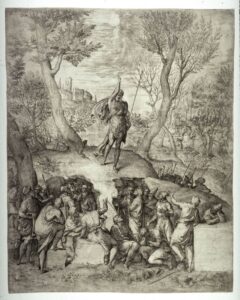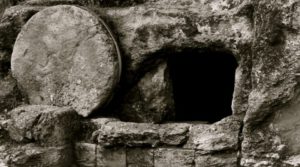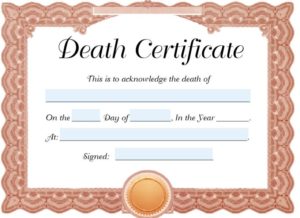John the Baptist – Confirmation of the Gospels?
John the Baptist is recognized as a real historical figure by fierce religion opponents of Christianity as well as a Roman Jewish historian. The Gospels feature John the Baptist as a prominent figure in the life of Jesus of Nazareth, too. Does the existence of John the Baptist lend credibility to the Gospel accounts?
John, the eyewitness Gospel, recognizes John the Baptist as the one who testified about the Light whom he identified as Jesus Christ.[1] Mark begins its Gospel immediately by declaring Jesus to be the Son of God, then declares John the Baptist fulfilled the prophecy of Isaiah 40:3 preparing the way for the LORD.[2]

Priests and Levites questioned John the Baptist about his true identity, but John denied he is the Messiah. Referencing the prophecy of Isaiah 40:3, the Baptist said it was a prophecy about himself as the forerunner of the Messiah:
JN 1:23 He said, “I am the voice of one crying out in the wilderness, ‘Make straight the way of the Lord,’” as the prophet Isaiah said. (NSRV)
IS 40:3 A voice cries out: “In the wilderness prepare the way of the LORD, make straight in the desert a highway for our God. (NSRV)
Affirming the existence of John the Baptist is a vehement opponent to the belief that Jesus is the Messiah – the Muslim religion. John the Baptist aka Yahya is referenced in four different books of the Quran. He is described as respectful and obedient to his parents, a devout, noble and chaste person – a prophet and a witness to the truth of the “Word” of God.[3]
Luke’s Gospel and the Quran both describe the miraculous circumstances of the birth of John the Baptist to the barren, aging Elizabeth. Her husband, Zachariah (Zakariya), was struck dumb when an angel delivered the message he was to be a father.[4]
Surah: 21:89-90a “And (remember) Zakariya, when he cried to his Lord… So We listened to him: and We granted him Yahya: We cured his wife’s (Barrenness) for him.”
One of the four Quran references establishes common ground with Judaism and Christianity. John the Baptist is placed in the same company of revered Godly Jewish leaders Abraham, Isaac, Jacob, Noah, David, Solomon, Job, Joseph, Moses, Aaron and…Jesus.[5]
Judaism is another passionate opponent to the Gospel’s proclamation that Jesus is the Messiah. Nevertheless, the Jewish Encyclopedia in its article for the “New Testament” makes references to the life and teachings of Jesus first starting with John the Baptist:
“The whole picture of John the Baptist and of Jesus as bearers of good tidings to the poor has the stamp of greater truthfulness.”– Jewish Encyclopedia[6]
Flavius Josephus was a Pharisee member of the Sanhedrin chosen as a general to lead the Jewish military. After his capture by the Romans, he became a Jewish historian for Rome. In his monumental work, Antiquity of the Jews, he significantly referenced John the Baptist in more than just a passing reference.[7]
“…John, that was called the Baptist for Herod slew him, who was a good man, and commanded the Jews to exercise virtue, both as to righteousness towards one another, and piety toward God, and so to come to baptism; for that the washing [with water] would be acceptable to him, if they made use of it, not in order to the putting away [or the remission] of some sins [only], but for the purifications of the body; supporting still that the soul was thoroughly purified beforehand by righteousness.” – Josephus
During a trip to Rome, according to Josephus, Herod Antipas stayed with his half-brother Herod Philip (their father was the late King Herod) and met Philip’s wife, Herodias, sister of Agrippa the Great.[8] The two became paramours who conspired to move in together and marry after they returned from Rome with the stipulation Antipas would divorce his current wife.
“…Herodius took upon her to confound the laws of our country, and divorced herself from her husband while he was alive, and was married to Herod [Antipas], her husband’s brother of the father’s side; he was tetrarch of Galilee; but her daughter Salome was married to Philip, the son of Herod, and tetrarch of Galilee…” – Josephus [9]
Unbeknownst to Herod Antipas, his current wife discovered the lover’s affair of her husband with Herodius. In a preemptive move, she requested to be sent to the castle of Macherus near her Arabian King father, Aretas.
Insulted by the infidelity against his daughter, Aretas sent his army to do battle with the troops of Herod Antipas allegedly over a boarder dispute. Aided by the secret troop support of his offended brother, Herold Philip, King Aretas defeated the army of Herod Antipas.[10]
“Herod, who feared lest the great influence John had over the people might put it into his power and inclination to raise a rebellion (for they seemed ready to do anything he should advise) thought it best, by putting him to death, to prevent any mischief he might cause, and not bring himself into difficulties, by sparing a man who might make him repent of it when it would be too late. Accordingly, he was sent a prisoner, out of Herod’s suspicious temper, to Macherus, the castle I before mentioned, and was there put to death…” – Josephus [11]
Twice stated by Josephus, some of the Jews believed the reason for the destruction of Herod Antipas’ army was a punishment from God for killing the Baptist:
“Now, some of the Jews thought that the destructions of Herod’s army came from God, and that very justly, as a punishment of what he did against John, called the Baptist, for Herod slew him, who was a good man…” [12]
Using the word “repent,” a word that carries a specific religious meaning, it had special connotations to a Pharisee such as Josephus.[13] In Judaism, to repent first requires an act against God’s Law followed by the transgressor’s confession, regret and a promise not to repeat it.[14] Antipas had no desire to repent or change his ways.
Reasons for why John the Baptist was executed can be two distinctly different things, yet both can be true. Matthew and Mark attribute the reason to a grudge held by Herodias for being shamed by John the Baptist for her illicit lifestyle.[15] Josephus attributed a political reason for his execution, the perception that he was a problematic political threat to Antipas. Either way, the problem was solved with the execution of John the Baptist.
An insider source may very well have been Joanna of the Gospels, household manager of Herod Antipas.[16] If not herself, she would have had inside contacts who had knowledge of intimate behaviors in the Herod Antipas’ family.
Judaism, Islam and Christianity, intense opponents of each other’s beliefs plus the secular Roman historian Josephus, all agree as a fact that John the Baptist was a real historical figure who was sent by God. With the role of John the Baptist being an integral part of the life of Jesus of Nazareth, does it confirm the truthfulness of the Gospels?
Updated September 3, 2023.
This work is licensed under a Creative Commons Attribution-NonCommercial-NoDerivatives 4.0 International License.>
REFERENCES:
[1] John 1:1-8. NASB, NIV, NKJV, NRSB. <http://classic.net.bible.org/bible.php?book=Joh&chapter=1> Fontana, Giambattista. Fine Arts Museum of San Francisco. “St. John the Baptist Preaching.” Mr. and Mrs. Marcus Sopher Collection. photo. 16th century. <https://art.famsf.org/giambattista-fontana/st-john-baptist-preaching-19861354>
[2] Mark 1:2-4. NASB, NKJV. NetBible.org. Footnotes #5, #7. < http://classic.net.bible.org/bible.php?book=Mar&chapter=1>
[3] Quran. Surah 3:39; 19:13-14. Quran. Trans. Abdullah Yusuf Ali. n.d. <http://search-the-quran.com>
[4] Luke 1:8-25. Quran. Surah: 3:38-41; 19:2-11; 21:89-91.
[5] Quran. Surah: 6:84-86.
[6] “New Testament.” Jewish Encyclopedia. 2011. <http://jewishencyclopedia.com/articles/11498-new-testament> CR Singer, Isidore; Adler, Cyrus, et. al. The Jewish Encyclopedia. Volume 9. 1912. “Luke.” p 251. <http://books.google.com/books?id=lfoOtGOcIBYC&lpg=PA594&ots=6qoCfVVUz7&dq=wave%20sheaf%20encyclopedia&pg=PA594#v=onepage&q&f=false>
[7] Josephus, Flavius. Antiquities of the Jews. Trans. and commentary. William Whitson. The Complete Works of Josephus. Book XVIII, Chapter V.2. <http://books.google.com/books?id=e0dAAAAAMAAJ&printsec=frontcover&source=gbs_ge_summary_r&cad=0#v=onepage&q&f=false>
[8] Josephus. Antiquities. Book XVIII, Chapter V.1
[9] Josephus. Antiquities. Book XVIII, Chapter V.4.
[10] Josephus. Antiquities. Book XVIII, Chapter V.1. Bunson, Matthew. Encyclopedia of the Roman Empire. “Herod Antipas.” 2002. <https://archive.org/details/isbn_9780816045624>
[11] Josephus. Antiquities. Book XVIII, Chapter V.2.
[12] Josephus. Antiquities. Book XVIII, Chapter V.2.
[13] Josephus. Antiquities. Book XVIII, Chapter V.2; Book VIII, Chapter XII.3. Josephus, Flavius. The Life of Flavius Josephus. #22. Trans. and Commentary. William Whitson. The Complete Works of Josephus. <http://books.google.com/books?id=e0dAAAAAMAAJ&printsec=frontcover&source=gbs_ge_summary_r&cad=0#v=onepage&q&f=false> Josephus, Flavius. Wars of the Jews. Book V, Chapter IX.4; Book VI, Chapter 2.1. Trans. and commentary. William Whitson. The Complete Works of Josephus. <http://books.google.com/books?id=e0dAAAAAMAAJ&printsec=frontcover&source=gbs_ge_summary_r&cad=0#v=onepage&q&f=false> CR Josephus. Antiquities. Book III, Chapter I.5; Book IV, Chapter III.14, Chapter VIII.2; Book VI, Chapters II.3, III.4; Book VII, Chapter XII.3; Chapter XIII.8.>
[14] Maimonides, Moses. Sefaria.org. Mishna Torah, Repentance 1. <https://www.sefaria.org/Mishneh_Torah%2C_Repentance.1?lang=bi> “Teshuvah, or Repentance.” MyJewishLearning.com. 2020. <https://www.myjewishlearning.com/article/repentance>
[15] Luke 8:3.
[16] Matthew 14:1-12; Mark 6:17-29. CR Luke 9:7-9; John 3:24. Josephus. Antiquities. Book XVIII, Chapter V.4. Bunson. Encyclopedia of the Roman Empire. “Herod Antipas; Herodias.”


